Network Security Management Assignment - [Module Name] - [University]
VerifiedAdded on 2020/04/15
|7
|983
|261
Homework Assignment
AI Summary
This document provides a detailed solution to a network security management assignment, covering several key concepts. The solution begins with step-by-step instructions for configuring and enabling a FastEthernet0/1 router interface with a specific IP address and subnet mask. It then explains how to identify whether a router's serial port is DCE or DTE. The solution also clarifies the meaning of the "Forward Delay" parameter in a BPDU data packet and discusses the suitability of using a layer 2 switch in the core of a campus network. Finally, it examines the factors to consider when setting up a data link between buildings in a campus network, comparing fiber optic, microwave, and other media options. The assignment includes references to relevant academic sources.
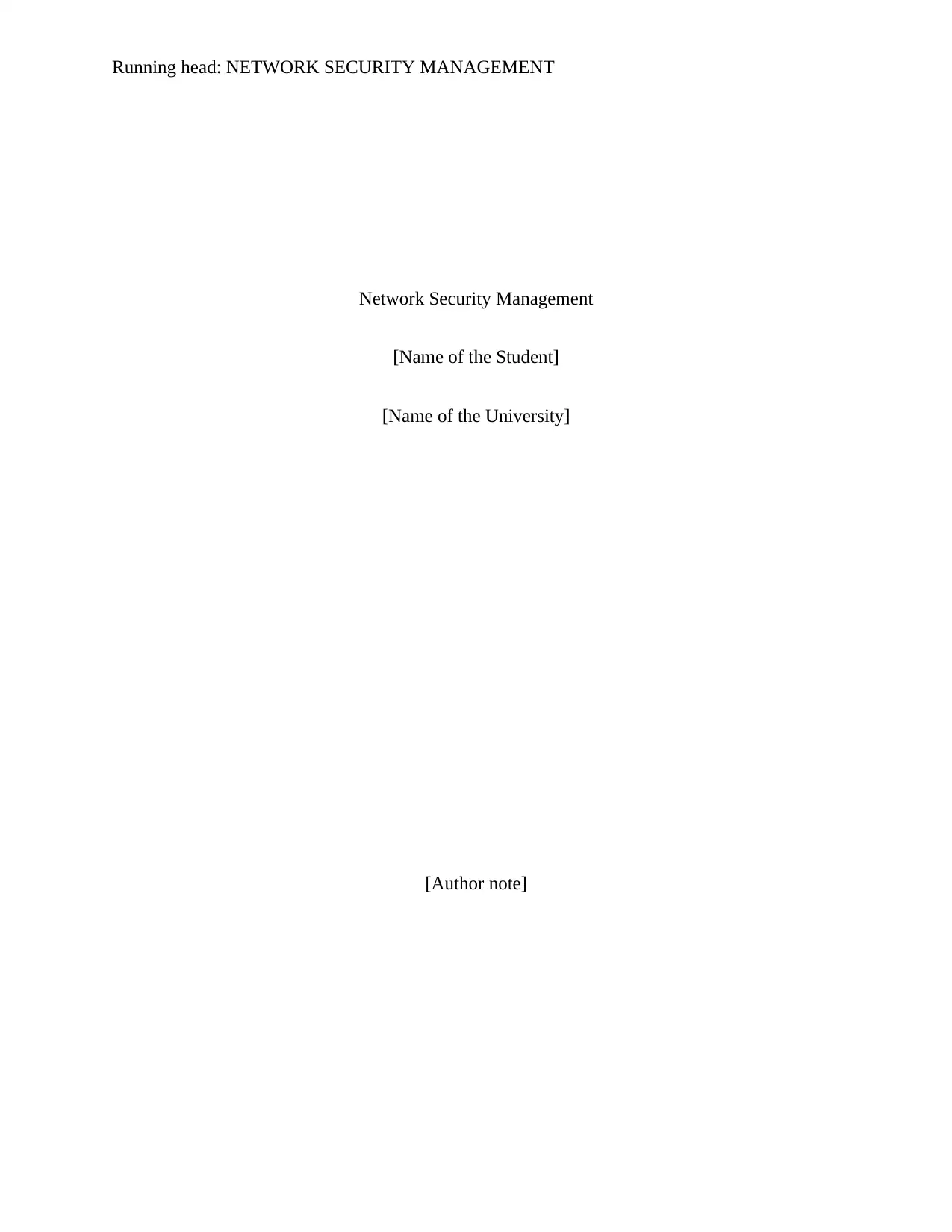
Running head: NETWORK SECURITY MANAGEMENT
Network Security Management
[Name of the Student]
[Name of the University]
[Author note]
Network Security Management
[Name of the Student]
[Name of the University]
[Author note]
Paraphrase This Document
Need a fresh take? Get an instant paraphrase of this document with our AI Paraphraser
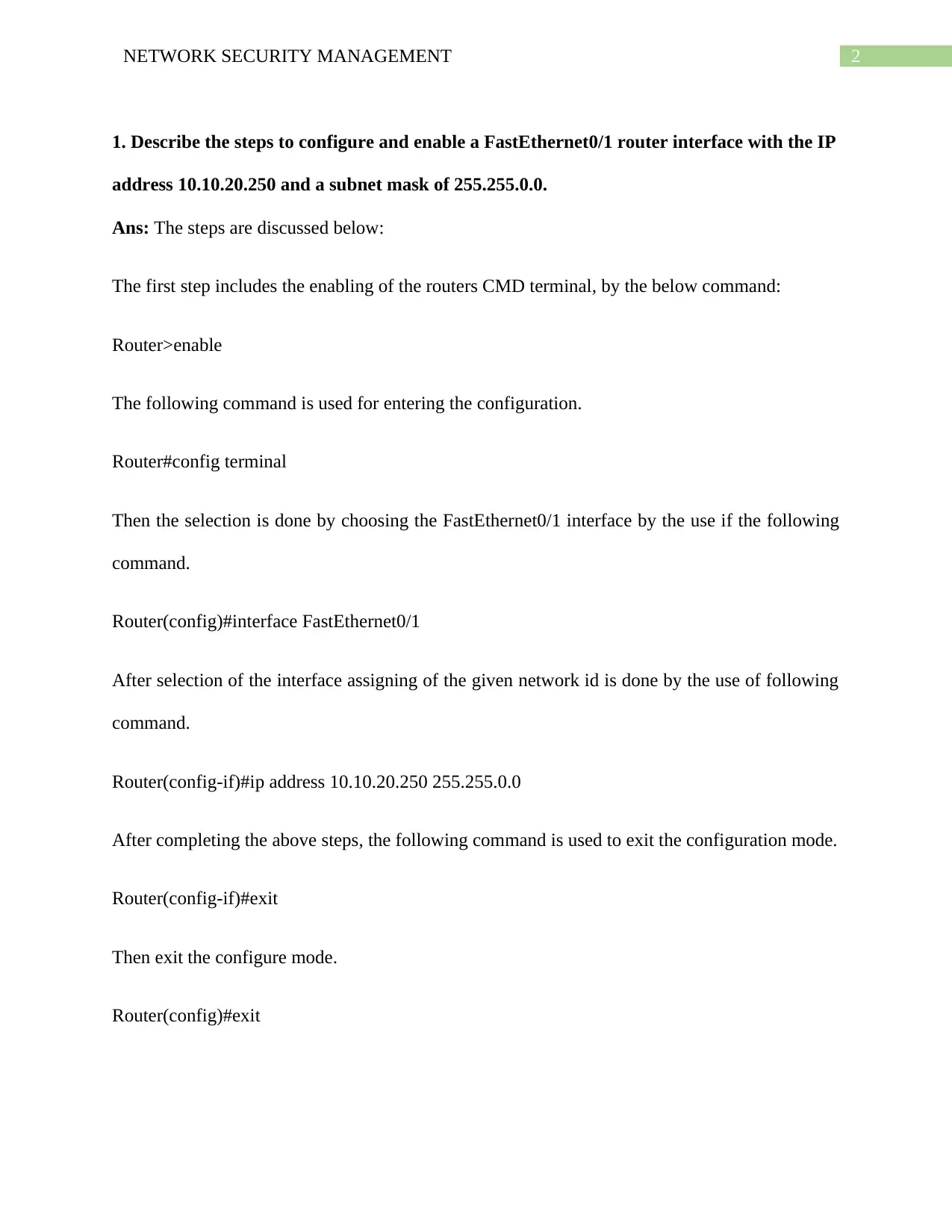
2NETWORK SECURITY MANAGEMENT
1. Describe the steps to configure and enable a FastEthernet0/1 router interface with the IP
address 10.10.20.250 and a subnet mask of 255.255.0.0.
Ans: The steps are discussed below:
The first step includes the enabling of the routers CMD terminal, by the below command:
Router>enable
The following command is used for entering the configuration.
Router#config terminal
Then the selection is done by choosing the FastEthernet0/1 interface by the use if the following
command.
Router(config)#interface FastEthernet0/1
After selection of the interface assigning of the given network id is done by the use of following
command.
Router(config-if)#ip address 10.10.20.250 255.255.0.0
After completing the above steps, the following command is used to exit the configuration mode.
Router(config-if)#exit
Then exit the configure mode.
Router(config)#exit
1. Describe the steps to configure and enable a FastEthernet0/1 router interface with the IP
address 10.10.20.250 and a subnet mask of 255.255.0.0.
Ans: The steps are discussed below:
The first step includes the enabling of the routers CMD terminal, by the below command:
Router>enable
The following command is used for entering the configuration.
Router#config terminal
Then the selection is done by choosing the FastEthernet0/1 interface by the use if the following
command.
Router(config)#interface FastEthernet0/1
After selection of the interface assigning of the given network id is done by the use of following
command.
Router(config-if)#ip address 10.10.20.250 255.255.0.0
After completing the above steps, the following command is used to exit the configuration mode.
Router(config-if)#exit
Then exit the configure mode.
Router(config)#exit
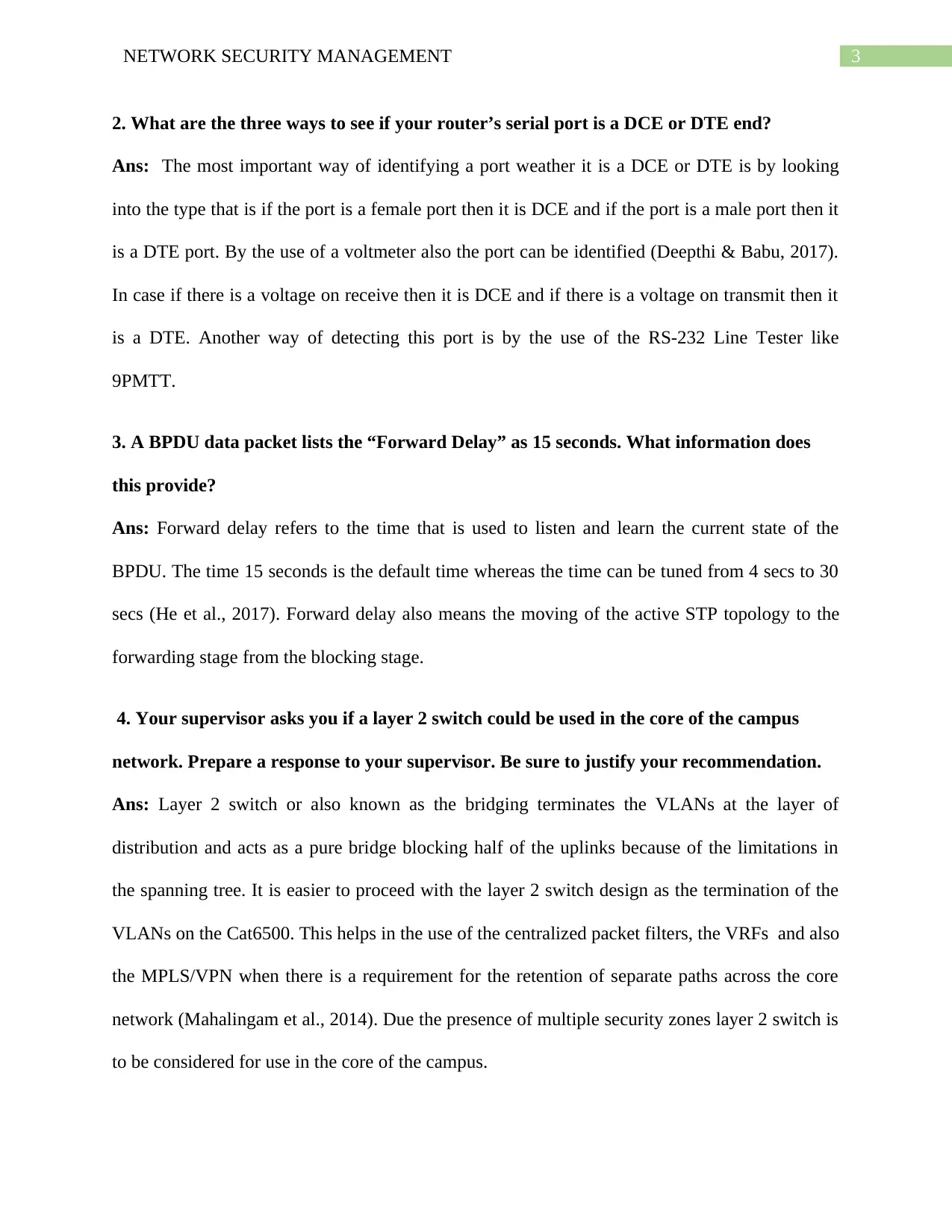
3NETWORK SECURITY MANAGEMENT
2. What are the three ways to see if your router’s serial port is a DCE or DTE end?
Ans: The most important way of identifying a port weather it is a DCE or DTE is by looking
into the type that is if the port is a female port then it is DCE and if the port is a male port then it
is a DTE port. By the use of a voltmeter also the port can be identified (Deepthi & Babu, 2017).
In case if there is a voltage on receive then it is DCE and if there is a voltage on transmit then it
is a DTE. Another way of detecting this port is by the use of the RS-232 Line Tester like
9PMTT.
3. A BPDU data packet lists the “Forward Delay” as 15 seconds. What information does
this provide?
Ans: Forward delay refers to the time that is used to listen and learn the current state of the
BPDU. The time 15 seconds is the default time whereas the time can be tuned from 4 secs to 30
secs (He et al., 2017). Forward delay also means the moving of the active STP topology to the
forwarding stage from the blocking stage.
4. Your supervisor asks you if a layer 2 switch could be used in the core of the campus
network. Prepare a response to your supervisor. Be sure to justify your recommendation.
Ans: Layer 2 switch or also known as the bridging terminates the VLANs at the layer of
distribution and acts as a pure bridge blocking half of the uplinks because of the limitations in
the spanning tree. It is easier to proceed with the layer 2 switch design as the termination of the
VLANs on the Cat6500. This helps in the use of the centralized packet filters, the VRFs and also
the MPLS/VPN when there is a requirement for the retention of separate paths across the core
network (Mahalingam et al., 2014). Due the presence of multiple security zones layer 2 switch is
to be considered for use in the core of the campus.
2. What are the three ways to see if your router’s serial port is a DCE or DTE end?
Ans: The most important way of identifying a port weather it is a DCE or DTE is by looking
into the type that is if the port is a female port then it is DCE and if the port is a male port then it
is a DTE port. By the use of a voltmeter also the port can be identified (Deepthi & Babu, 2017).
In case if there is a voltage on receive then it is DCE and if there is a voltage on transmit then it
is a DTE. Another way of detecting this port is by the use of the RS-232 Line Tester like
9PMTT.
3. A BPDU data packet lists the “Forward Delay” as 15 seconds. What information does
this provide?
Ans: Forward delay refers to the time that is used to listen and learn the current state of the
BPDU. The time 15 seconds is the default time whereas the time can be tuned from 4 secs to 30
secs (He et al., 2017). Forward delay also means the moving of the active STP topology to the
forwarding stage from the blocking stage.
4. Your supervisor asks you if a layer 2 switch could be used in the core of the campus
network. Prepare a response to your supervisor. Be sure to justify your recommendation.
Ans: Layer 2 switch or also known as the bridging terminates the VLANs at the layer of
distribution and acts as a pure bridge blocking half of the uplinks because of the limitations in
the spanning tree. It is easier to proceed with the layer 2 switch design as the termination of the
VLANs on the Cat6500. This helps in the use of the centralized packet filters, the VRFs and also
the MPLS/VPN when there is a requirement for the retention of separate paths across the core
network (Mahalingam et al., 2014). Due the presence of multiple security zones layer 2 switch is
to be considered for use in the core of the campus.
⊘ This is a preview!⊘
Do you want full access?
Subscribe today to unlock all pages.

Trusted by 1+ million students worldwide

4NETWORK SECURITY MANAGEMENT
Paraphrase This Document
Need a fresh take? Get an instant paraphrase of this document with our AI Paraphraser
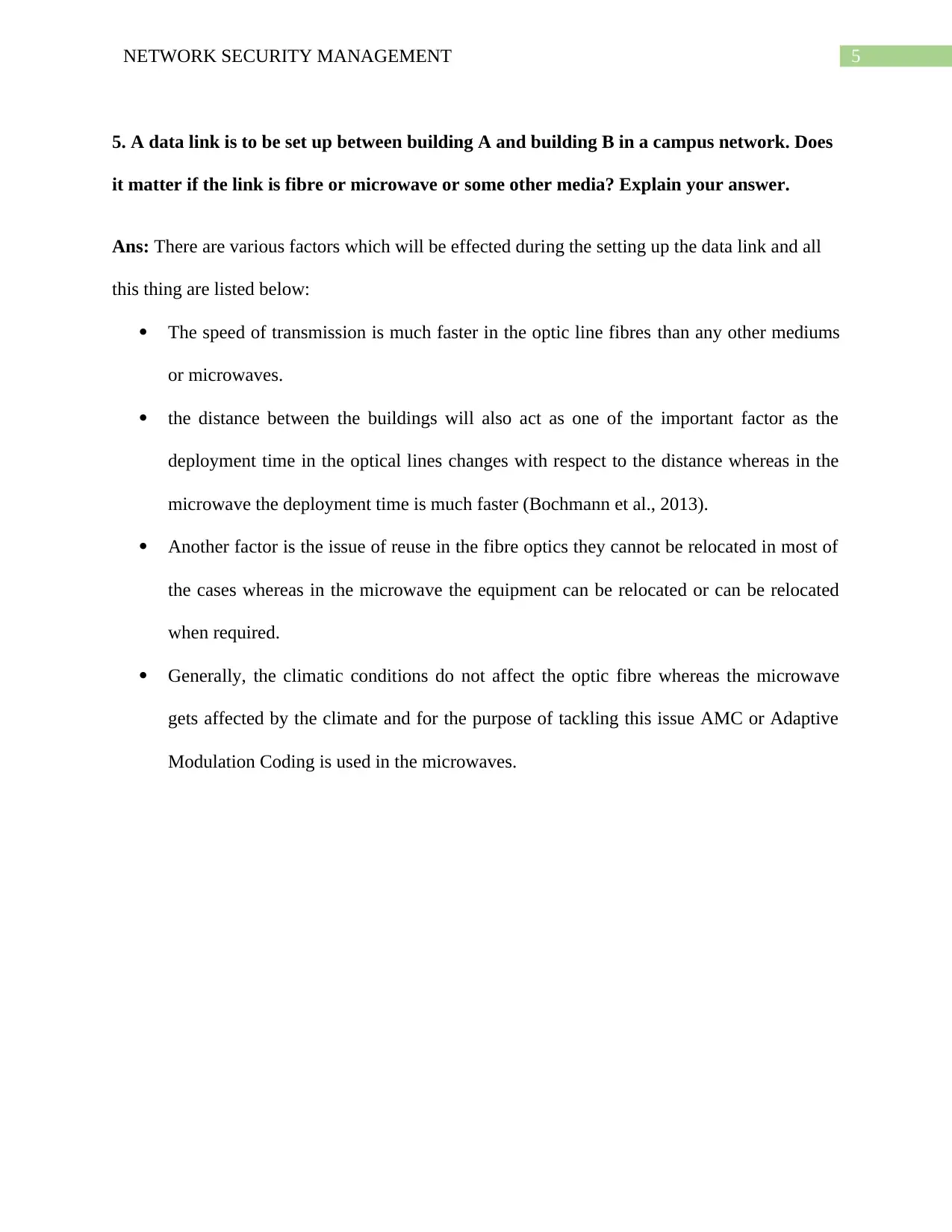
5NETWORK SECURITY MANAGEMENT
5. A data link is to be set up between building A and building B in a campus network. Does
it matter if the link is fibre or microwave or some other media? Explain your answer.
Ans: There are various factors which will be effected during the setting up the data link and all
this thing are listed below:
The speed of transmission is much faster in the optic line fibres than any other mediums
or microwaves.
the distance between the buildings will also act as one of the important factor as the
deployment time in the optical lines changes with respect to the distance whereas in the
microwave the deployment time is much faster (Bochmann et al., 2013).
Another factor is the issue of reuse in the fibre optics they cannot be relocated in most of
the cases whereas in the microwave the equipment can be relocated or can be relocated
when required.
Generally, the climatic conditions do not affect the optic fibre whereas the microwave
gets affected by the climate and for the purpose of tackling this issue AMC or Adaptive
Modulation Coding is used in the microwaves.
5. A data link is to be set up between building A and building B in a campus network. Does
it matter if the link is fibre or microwave or some other media? Explain your answer.
Ans: There are various factors which will be effected during the setting up the data link and all
this thing are listed below:
The speed of transmission is much faster in the optic line fibres than any other mediums
or microwaves.
the distance between the buildings will also act as one of the important factor as the
deployment time in the optical lines changes with respect to the distance whereas in the
microwave the deployment time is much faster (Bochmann et al., 2013).
Another factor is the issue of reuse in the fibre optics they cannot be relocated in most of
the cases whereas in the microwave the equipment can be relocated or can be relocated
when required.
Generally, the climatic conditions do not affect the optic fibre whereas the microwave
gets affected by the climate and for the purpose of tackling this issue AMC or Adaptive
Modulation Coding is used in the microwaves.
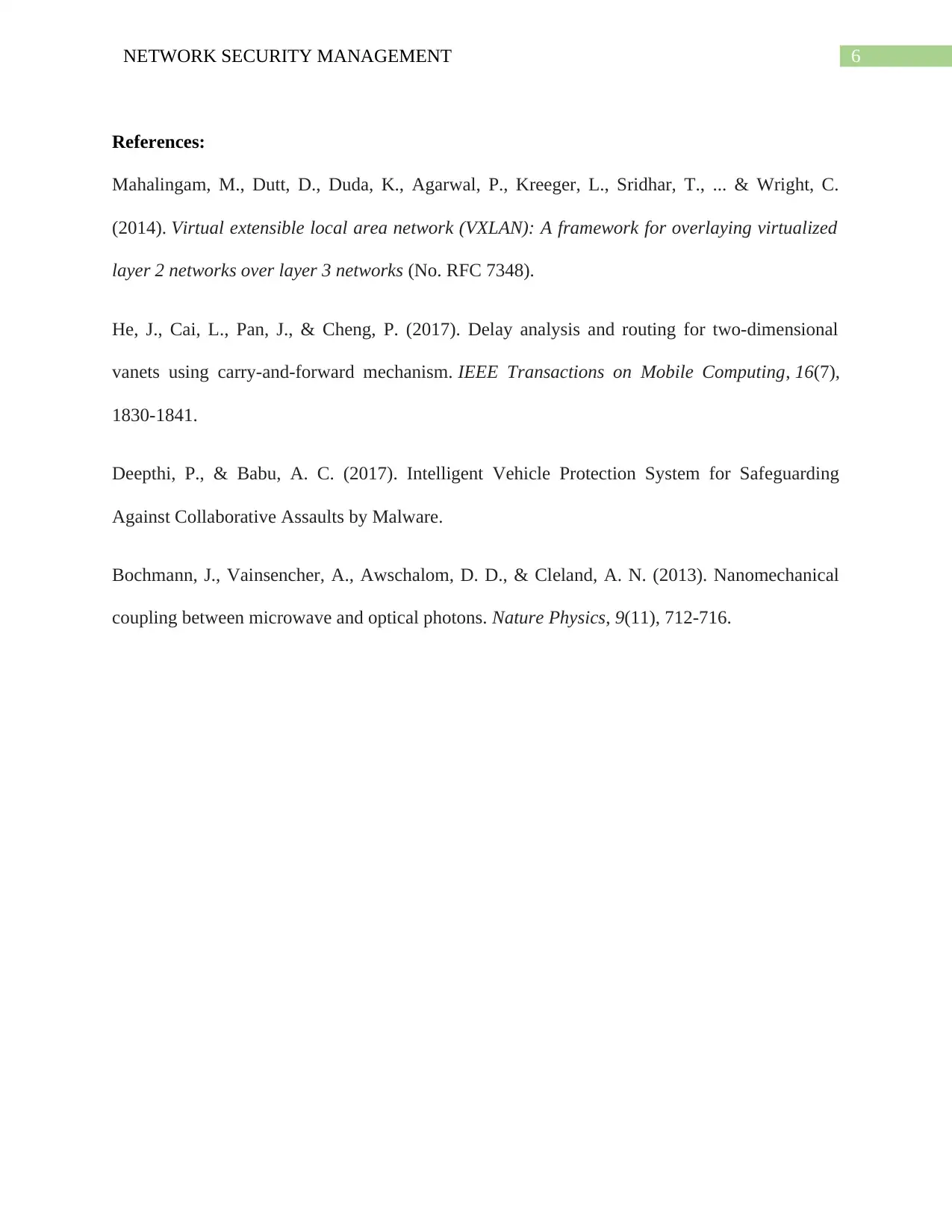
6NETWORK SECURITY MANAGEMENT
References:
Mahalingam, M., Dutt, D., Duda, K., Agarwal, P., Kreeger, L., Sridhar, T., ... & Wright, C.
(2014). Virtual extensible local area network (VXLAN): A framework for overlaying virtualized
layer 2 networks over layer 3 networks (No. RFC 7348).
He, J., Cai, L., Pan, J., & Cheng, P. (2017). Delay analysis and routing for two-dimensional
vanets using carry-and-forward mechanism. IEEE Transactions on Mobile Computing, 16(7),
1830-1841.
Deepthi, P., & Babu, A. C. (2017). Intelligent Vehicle Protection System for Safeguarding
Against Collaborative Assaults by Malware.
Bochmann, J., Vainsencher, A., Awschalom, D. D., & Cleland, A. N. (2013). Nanomechanical
coupling between microwave and optical photons. Nature Physics, 9(11), 712-716.
References:
Mahalingam, M., Dutt, D., Duda, K., Agarwal, P., Kreeger, L., Sridhar, T., ... & Wright, C.
(2014). Virtual extensible local area network (VXLAN): A framework for overlaying virtualized
layer 2 networks over layer 3 networks (No. RFC 7348).
He, J., Cai, L., Pan, J., & Cheng, P. (2017). Delay analysis and routing for two-dimensional
vanets using carry-and-forward mechanism. IEEE Transactions on Mobile Computing, 16(7),
1830-1841.
Deepthi, P., & Babu, A. C. (2017). Intelligent Vehicle Protection System for Safeguarding
Against Collaborative Assaults by Malware.
Bochmann, J., Vainsencher, A., Awschalom, D. D., & Cleland, A. N. (2013). Nanomechanical
coupling between microwave and optical photons. Nature Physics, 9(11), 712-716.
⊘ This is a preview!⊘
Do you want full access?
Subscribe today to unlock all pages.

Trusted by 1+ million students worldwide

7NETWORK SECURITY MANAGEMENT
Bibliography:
Medhi, D., & Ramasamy, K. (2017). Network routing: algorithms, protocols, and architectures.
Morgan Kaufmann.
Bibliography:
Medhi, D., & Ramasamy, K. (2017). Network routing: algorithms, protocols, and architectures.
Morgan Kaufmann.
1 out of 7
Related Documents
Your All-in-One AI-Powered Toolkit for Academic Success.
+13062052269
info@desklib.com
Available 24*7 on WhatsApp / Email
![[object Object]](/_next/static/media/star-bottom.7253800d.svg)
Unlock your academic potential
Copyright © 2020–2025 A2Z Services. All Rights Reserved. Developed and managed by ZUCOL.
![Network Management Homework - [University Name] - [Semester]](/_next/image/?url=https%3A%2F%2Fdesklib.com%2Fmedia%2Fimages%2Fur%2F9610cb4b2ab64eba8a490cd1d249863c.jpg&w=256&q=75)




